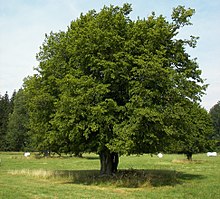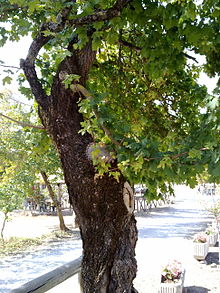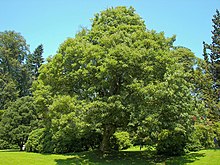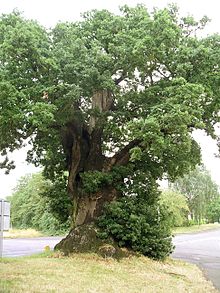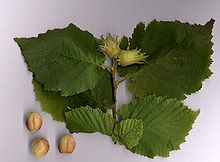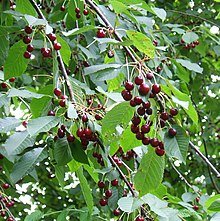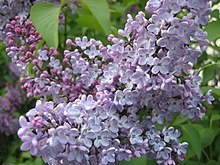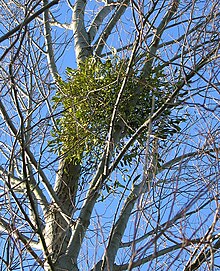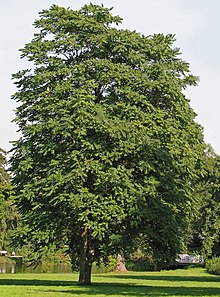Flora
The landscape architecture, originally conceived by H. Mattern and H. Raderschall, envisaged that something would bloom in every season and that trees and shrubs from different hemispheres would characterize the settlement. This concept need to be preserved, in compliance with the "Ensembleschutz" and the tree protection statutes of the city of Bonn. The following tree and shrub species are currently present in the settlement. In addition, here is the link to the original landscape planning Source: TU-Berlin.
Trees, hedges and shrubs
Listing in progress, click on the images to read the related Wikipedia article.
In addition to the trees, shrubs and plants listed here, the flora of the settlement still offers many varieties of grasses, meadows and blooming flowers. Flowering strips also contribute to the biodiversity of the settlement, but here only on the non-urban properties. If you know of any other tree, shrub or plant species that are proven to be native to the settlement, please let us know.
Fauna
In the course of time, various animal species have settled in this park-like landscape. If you know of other animal species that are demonstrably native to the settlement, or have their territory please let us know. We are also happy to receive suggestions for the inclusion of additional animal species as well as classifications of subspecies. Listing in progress, a click on the image leads to further information on Wikipedia.
The following wild animal species are demonstrably represented in the settlement, some of which already belong to rare and therefore worthy of protection species. It is important to preserve the habitat of these animals and their species by not changing the character of the settlement to the detriment of the fauna living in it, so that we can continue to enjoy their diversity.
Mammals
| Picture | Name | Description |
|---|---|---|
 |
Eurasian red squirrel (Sciurus vulgaris) | This cute little animal, a member of the squirrel family, has always felt at home in the settlement and is considered a specially protected species under the Federal Nature Conservation Act. |
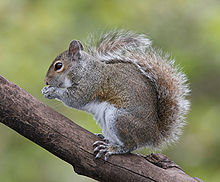 |
Grey squirrel (Sciurus carolinensis) | The relative of the European squirrel, also known as the gray squirrel, migrated from North America and has become a part of the settlement. Unfortunately, this species displaces the native squirrels and is on the List of Invasive Alien Species of Union concern. |
 |
Fat dormouse (Glis glis) | This nocturnal rodent requires woods for its daytime sleep and is likely to be seldom seen. In winter, it burrows in the ground for a little over seven months, or hibernates in buildings. Its biggest predators are martens, house cats or larger owls. |
 |
European rabbit (Oryctolagus cuniculus) | Children especially love them and like to confuse them with rabbits. The rabbits in Europe are repeatedly afflicted by epidemics, which decimate their numbers more and more. Therefore, the wild rabbit is classified by the International Union for Conservation of Nature and Natural Resources as a species on the near threatened list. In the settlement they like to hop around between the houses on the meadows in the early morning and in the evening. |
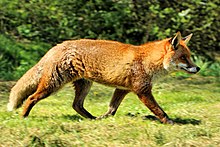 |
Red Fox (Vulpes vulpes) | Every child in Germany knows "the fox" (Fuchs Du hast die Gans gestohlen), but caution is advised in encounters with this predator: if a fox behaves tamely or conspicuously, it most likely has rabies, a carankind disease that is contagious and sometimes fatal for humans. Foxes, like wild boars and wolves, are increasingly invading human habitats, as their natural reserves are becoming less and less available, but have so far rarely been sighted in settlements. |
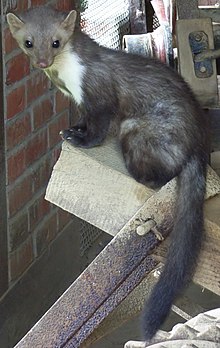 |
Beech marten (Martes foina) | According to unconfirmed reports, this predator also feels at home in the settlement. They are nocturnal and like to eat small mammals, but also feed on berries and fruits, rumored on cables in cars. |
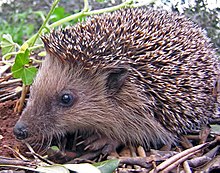 |
Hedgehog *(Erinaceidae) | Hedgehogs are most likely to be observed in the settlement at dusk, at night they can also be recognized by their loud smacking sounds. In the settlement they find shelter in the dense undergrowth and under bushes and hedges. The number of hedgehogs has decreased significantly in Germany and other countries due to lack of habitat and the use of pesticides. However, we can proudly announce for the settlement that in July 2022 there were offspring of 5 small hedgehogs. Two of them can be observed in this short film. |
| Bat (species unknown) | There are 24 native species of bats living in Germany. All these bats are under nature conservation or species protection. But only two of these species are not acutely endangered. Especially the reduction of habitat as well as the scarcity of food - both caused by humans - are causing a decline in populations. For this reason, bat conservation is particularly important, although it faces major challenges, including in the American Settlement. If the habitat of these mammals is further destroyed by redevelopment or remodeling and removal of trees, hedges and shrubs, this species will become extinct. In this regard, the Federal Natural Resources Conservation Act and the Federal Species at Risk Act provide penalties, up to and including imprisonment, for disturbing and/or killing this species. |
Birds
| Picture | Name | Description |
|---|---|---|
 |
spotted woodpecker (Dendrocopos major) | The typical tok tok tok of the woodpecker searching under the bark for insects and worms echoes through the settlement in spring. |
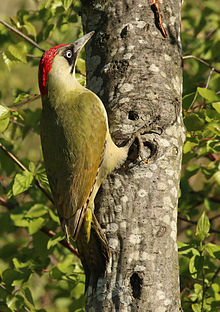 |
green woodpecker (Picus viridis) | This green-feathered fellow is often found here pecking at the ground in search of insects and worms. |
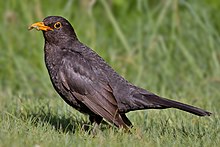 |
common blackbird (Turdus merula) | This original forest bird delights us with its pretty song in the morning and evening. Blackbirds are free breeders and nest mainly in trees and shrubs found in the settlement. |
| Sparrow (species unknown) | Also called sparrow in the vernacular. | |
 |
Nuthatch (Sitta europaea) | To protect the burrow from marten or crow access, nuthatches "wall up" the entrance to their breeding burrows with a mixture of clay and saliva, so they need tree stands with nesting holes. Because of its uniqueness and the close connection to forests with old tree existence the Naturschutzbund Deutschland e. V. and BirdLife Austria selected the nuthatch as bird of the year 2006 in Germany and Austria on October 7, 2005. This is also a plea for the protection of oak and beech forests and their populations. |
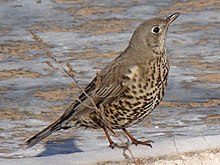 |
mistle thrush (Turdus viscivorus) | The mistle thrush is the largest native thrush in Europe. Its song consists of short, repetitive, melancholic fluting, far carrying song stanzas, which can be enjoyed in the settlement even at noon. |
 |
Redstart (Phoenicurus) | The common- or black redstart is a small migratory bird that, as a cavity and half-cavity nesting bird, inhabits mainly light deciduous forests, parks and gardens with old trees, such as those of the settlement. In the Czech Republic, Switzerland and Austria, the Redstart is already on the Red Lists of endangered species. |
 |
song thrush (Turdus philomelos) | This migratory bird is found throughout Europe and shows a preference for coniferous trees, much and dense undergrowth, shade and high humidity. A song thrush can live up to 18 years and sometimes sings, so heard in the settlement, up to 50 minutes. |
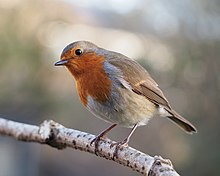 |
European robin (Erithacus rubecula) | this day and twilight active trusting little fellow with the red chest coloration is not easy to miss. It feels at home in bushes, hedges and in the undergrowth of the settlement. Its beautiful song begins about an hour before sunrise and can be heard in the settlement until dusk almost all year round. |
 |
nightingale (Luscinia megarhynchos) | Of these inconspicuous little birds, unpaired nightingales sing from about eleven o'clock at night until morning, and so can be heard in the settlement. They master between 120 and 260 different types of strophes, most of which are two to four seconds long. The extremely extensive repertoire is thus almost unique among European songbirds. The Natchtigall feels at home in the dense bushes of the settlement and feeds on insects and their larvae, worms or caterpillars. Whether the phrase Nachtigall, ick hör' dir trapsen has anything to do with the plans to destroy the settlement has not yet been proven. |
 |
Eurasian blue tit (Cyanistes caeruleus) | |
 |
Great tit (Parus major) | |
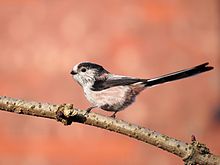 |
Long-tailed tit (Aegithalos caudatus) | |
 |
Coal tit (Periparus ater) | |
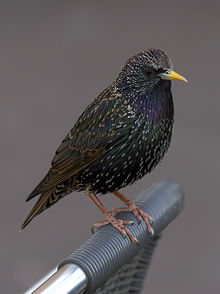 |
European starling (Sturnus vulgaris) | This migratory and flocking bird is one of the most common birds in the world and can live over 20 years in a single case. The starling is famous for its "mocking", its ability to imitate animal voices and sounds. So it is not necessarily your cell phone that rings when you hear a ringtone while walking through the settlement. |
| Finches (species unknown) | ||
 |
chaffinch (Fringilla coelebs) | The colorful feathered chaffinch is one of the most widespread songbirds in Europe. The chaffinch prefers to breed in the sparse deciduous trees as well as in the hedges of the settlement. |
 |
Goldfinch (Carduelis carduelis) | For nesting, the goldfinch prefers high places that provide cover combined with a good view. It often chooses a nesting site high in the treetops or in tall shrubs of the settlement. It feeds on seeds of perennials, meadow plants, trees as well as wild herbs and insects. |
 |
treecreeper (Certhia brachydactyla) | The garden treecreeper typically climbs tree trunks, supporting itself with its long tail and moving upwards in small jumps. It can be observed in the settlement particularly often on deciduous trees, which have a particularly deeply furrowed bark, where it finds insects, spiders, beetles and larvae under the bark. It builds its nest in tree crevices and behind loose bark. The population status of the garden treecreeper was classified as "Least Concern (LC)" = "not endangered" in the IUCN Red List of Threatened Species in 2032. |
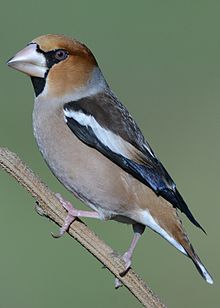 |
Hawfinch (Coccothraustes coccothraustes) | The hawfinch usually builds its nest on the trunk in branch whorls and forks, in tree crowns and on almost horizontal side branches of trees and in the shrubs of the settlement. The Hawfinch feeds mainly on the seeds of deciduous trees and fruits. |
 |
Wood pigeon (Columba palumbus) | This largest pigeon species of Central Europe settles in wooded landscapes of all kinds; if necessary, however, single trees or bushes are also sufficient for a settlement. The wood pigeon feeds almost exclusively on acorns, beechnuts and cereal seeds. |
 |
Black-headed gull (Chroicocephalus ridibundus) | This small gull species uses the meadows of the settlement as a resting area and is mainly found in the floodplains of the Rhine. |
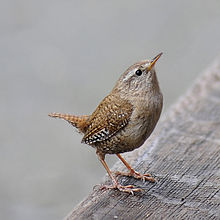 |
Eurasian wren (Troglodytes troglodytes) | This third smallest bird in Europe is with its up to 90 decibels loud song in the settlement, mainly at dusk, unmistakable. The wren nests in trees and bushes and needs hiding places in hedges. In stories, the wren has a reputation of cunning and cunning, let's hope that it will help us preserve the settlement and its character with it. |
 |
Rose-ringed parakeet (Psittacula krameri) | This most widespread parrot species is rumored to have escaped from Cologne Zoo and now colonizes large parts of the Rhine, as far as Switzerland. The darting flying acrobats are always marveled at by visitors and residents in the settlement. |
 |
Eurasian jay (Garrulus glandarius) | This medium-sized corvid is conspicuous for its blue-black banded plumage. The jay also breeds in forest-like habitats, requiring a territory size of between 2 and 10 hectares, as is also the case in settlements. Its diet includes mainly caterpillars of butterflies and leaf wasps, as well as beetles, caterpillars and grubs, but also smaller vertebrates and carrion. Its loud and raucous call is heard here mainly as an alarm call. |
 |
Eurasian magpie (Pica pica) | due to its characteristic black and white plumage with the strikingly long tail feathers, this raven bird is clearly recognizable. The magpie is one of the most intelligent birds and one of the few known birds to have passed the mirror test. The magpie mainly inhabits well-structured, partly open landscapes with meadows, hedges, bushes and single groups of trees, as they can be found in settlements. In contrast to Asia, where it is traditionally considered a good luck charm, in Europe its reputation as a harbinger of doom persists. The clucking of the magpie can serve as an alarm clock (especially early in the morning). |
 |
Carrion crow (Corvus corone) | Raven crows are known for their intelligent behavior and can remember faces and events, which some walkers in the settlement already painfully experienced. Therefore at this point the reference to the general leash obligation. Raven crows are omnivores and feed very versatile, unfortunately, for this they also search the trash cans open to the top in the settlement and distribute the garbage. By the way, the raven crow is related to the American crow, if that is not a sign? |
 |
House martin (Delichon urbicum) | House martins are particularly easy to identify by their white rump, which no other European swallow species displays. They reach flight speeds of up to 74 km/h and are very eager callers. House martins depend on open areas with low vegetation, such as those found in settlements. This allows them to hunt aerial plankton even when it flies low due to rainy or stormy weather. The proximity of larger bodies of water is equally necessary to find suitable nesting material, which is also present around the settlement. The average age of a House Martin population is only two years, with only ten adult House Martins reaching the next year of life. The 2020 Red List of Breeding Birds of Germany lists the species in category 3 as endangered. |
 |
Swift (Apus apus) | |
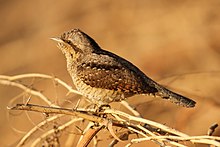 |
Eurasian wryneck (Jynx torquilla) | The wryneck has bark-colored, grayish-brown plumage as well as a strikingly long, grayish-brown tail. Wrynecks inhabit open and semi-open climatically favored landscapes with at least single trees, preferably parklands, gladly with quarry walls, such as those found in settlements. As a long-distance migratory bird, it sees much of the world and, with its conspicuous head turn, certainly views settlement with particular interest. |
| Heron (species unknown) | rest area | |
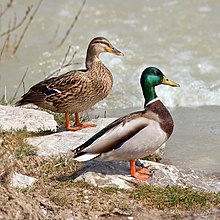 |
Wild duck (Anas platyrhynchos) | rest- an breeding ground |
 |
Graylag goose (Anser anser) | rest area |
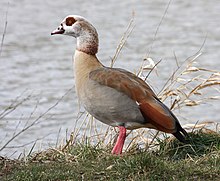 |
Egyptian goose (Alopochen aegyptiaca) | rest area |
 |
hunting area | |
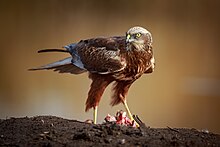 |
hunting area | |
| Falcon (species unknown) | hunting area | |
 |
tawny owl (Strix aluco) | |
 |
Barn Owl (Tyto alba) | unconfirmed, strictly protected species |
 |
Eagle owl (Bubo bubo) | This species, which is especially strictly protected according to the Federal Nature Conservation Act, has already been sighted several times in the settlement. This largest European owl uses the trees and wide areas between the houses at dusk as a hunting ground for mammals and birds. |
Insects
| Bild | Name | Beschreibung |
|---|---|---|
 |
Libellen (Odonata) | Species unknown |
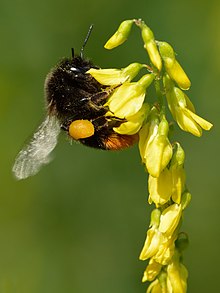 |
Bumblebee (Bombus) | Species unknown |
 |
Wild Bee | The term "wild bee" does not really exist in the biological sense, rather "wild species" of the western honey bee (Apis mellifera) should be assumed. These industrious pollen collectors pollinate plants, without them growth in nature would hardly be possible. All the more important is the protection of these small insects, not only for the sake of honey. |
For the identification of rare and protected species, we are guided by the Berne Convention and the Fauna-Flora-Habitat Directive of protected species and habitats. Of course, in addition, many more animals live in the settlement, such as snails, butterflies, etc.. For the completion and/or further determination of sub-species we look forward to your cooperation. Please contact insomeoneelsefo[at]amisiedlungbonn.de.
Source of Pictures/Text: Wikipedia

